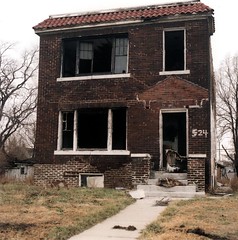 The Palladium-Item has an extensive look in today's paper at the issue of blight in Richmond, Indiana, including a companion article about how local residents can help address blight.
The Palladium-Item has an extensive look in today's paper at the issue of blight in Richmond, Indiana, including a companion article about how local residents can help address blight.
The article does a good job of summarizing the challenges of blight as amplified by rough economic times: property owners who might already struggle with maintenance and upkeep are even more at risk of letting a given structure or piece of land fall into disrepair when finances get tight and layoffs and foreclosures are looming. With such a high percentage of Richmond's residences being rentals, there's possibility for further disconnect between the state of the property and the owner's involvement in it.
My impression from the article and from the conversations I've had with city leaders is that Richmond is generally doing what it can to respond to the impact of decaying properties. But it can be discouraging to know that the process of getting a blighted property owner's attention is often drawn out over a long time and a lot of paperwork, not to mention expenditure of taxpayer dollars: wait for the property to be reported as blighted, flag it, mow it or repair it and bill the property owner, wait for the bill to go unpaid, place a lein on the property, and THEN there MIGHT be a financial incentive for some action. This routine may bear the customary government trademarks of caution and glacial due process, but it doesn't recognize very well the shorter-term impacts (financial and social) of a property falling into disrepair, and the ripple effect it can have on other areas nearby.
That particular concern is probably better taken up by neighborhoods and communities of neighbors than by municipal government, though. When a given area has a strong sense of community or neighborhood identity, perhaps through the work of an active neighborhood association, it's harder for any one property or resident to get left behind. When people know their neighbors and understand what personal and financial constraints are at work, there may be more opportunities to lend a hand and stop a bad situation from getting worse in a way that more deeply impacts the whole neighborhood. When we have vibrant and accessible public spaces, including a healthy downtown and surrounding arts and cultural districts, we have more opportunities to pool together our shared investment in the health of the city.
Of course, blight is a symptom of some other troubling trends as much as it is a cause. Richmond can check off many of Wikipedia's list of sources of urban decay:
It may feature deindustrialization, depopulation or changing population, economic restructuring, abandoned buildings, high local unemployment, fragmented families, political disenfranchisement, crime, and a desolate, inhospitable city landscape...Urban decay has no single cause; it results from combinations of inter-related socio-economic conditions—including the city’s urban planning decisions, the poverty of the local populace, the construction of freeway roads and rail road lines that bypass the area, depopulation by suburbanization of peripheral lands, real estate neighborhood redlining, and xenophobic immigration restrictions.
As much as we should be working to address blight in Richmond, we need to also develop a holistic view of these underlying causes, and develop a long-term approach that not only focuses on revitalizing Richmond's residential areas, but also on building a vibrant and self-reliant city as a whole.
 I’m a journalist, publisher, software developer and entrepreneur with experience as a founder and organizational leader. Work with me or learn more about me.
I’m a journalist, publisher, software developer and entrepreneur with experience as a founder and organizational leader. Work with me or learn more about me.
Some really good points, Chris RT @ChrisHardie New post: Blight in Richmond http://bit.ly/pve77p